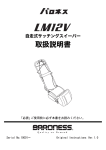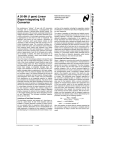Download Electric Lock (LM148) Installation Manual
Transcript
Electric Lock (LM148) Installation Manual Thank you for purchasing the electric lock for Sliding Gate Operator DSC 600/1000, DSR 600/1000. Once your sliding gate is separated to 2 parts, you can use the electric lock to lock the moving part against the standing part with your pleasure. Read the manual carefully and completely before you install the electric lock. Electric Lock Part List Important Information 1. Before you install the Electric Lock please be sure the gate is level, moves freely, and does not bind or block against barriers. 2. The lock and receiver could be installed on either slide gate with your pleasure. 3. For the Electric Lock to work correctly, the gate must close firmly engage the lock catch against the lock receiver. Installation Step 1: Disengage the clutch of the operator with the Triangular Key, you can moves the gate by hand, ensure both two parts of the gate can slide freely during installation of the Electric Lock. Step 2: With the gate in the closed position, determine the best location for the lock and receiver. The lock and the socket of the receiver must be Horizontal Centers aligned with each other. The lock and receiver should have a solid surface or tube fence to provide stability. Step 3: For Metallic Tube gate, if the thickness of the fence post is larger than or equal to 3mm, you can threading on the fence post, fasten the lock and receiver only use bolts (Figure B. Without washers and nuts). Otherwise, drill holes through out the fence post, fasten the lock and receiver with bolts, lock washers and nuts. For Chain Link gate, you will need U-Bolts, saddles, lock washers and nuts for the lock and receiver. Step 4: Recheck the lock’s position and alignment, make sure the electric lock to work correctly. Step 5: Connect the lock’s power cables to the DSR/DSC 600/1000 ’s control board (Figure C). 1 Note: Be sure that the clutch of the operator is engaged before you prepare to activate it. (Use the Triangular Key) Figure A Figure B Figure C 2





